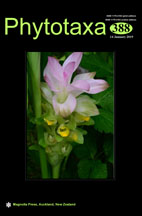Abstract
The Gelidium species are susceptible to a great phenotypic plasticity. In this genus, studies integrating morphological and molecular data have been increasingly used to define species. To date nine Gelidium species are reported along the Brazilian coast. Gelidium floridanum is the most frequently recorded species in Brazilian but it is also often confused with morphologically similar species, especially in the field or when reproductive structures are absent. In this study we analyzed specimens from Brazil previously identified as G. floridanum based on the morphological and molecular data (cox1 and rbcL DNA sequences). Newly collected specimens from Brazil showed a DNA sequence divergence from G. floridanum in the order of 1.0–1.4% for rbcL and 4.2% for cox1, enough to be considered a new species, here described as Gelidium guimaraesiae sp. nov.

